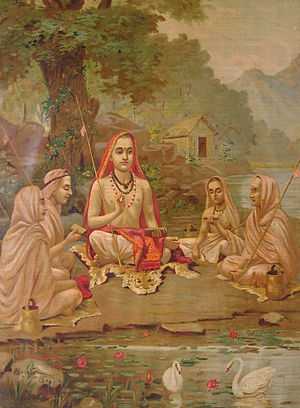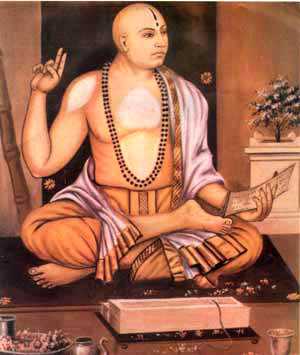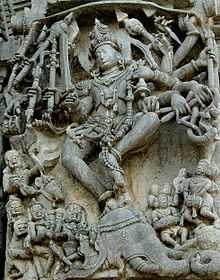Hinduism in Karnataka

Hinduism ((Sanskrit सिन्धु "Sindhu" (Indus River) + ism) is a term with wide connotations in the religious traditions of India. It is the largest religion in Karnataka, the southwest Indian state. Several great empires and dynasties have ruled over Karnataka and many of them have contributed richly to the growth of Hinduism, its temple culture and social development. These developments have reinforced the "Householder tradition", which is of disciplined domesticity, though the saints who propagated Hinduism in the state and in the country were themselves ascetics. The Bhakti movement, of Hindu origin, is devoted to the worship of Shiva and Vishnu; it had a telling impact on the sociocultural ethos of Karnataka from the 12th century onwards.
Movements



Karnataka was the birthplace of several notable Hindu movements.[1] The three most prominent movements of Vedanta Hinduism -- Advaita Vedanta, Vishishtadvaita and Dvaita -- began in Karnataka. The Dvaita Madhvacharya, who was from Karnataka, was the chief proponent of Tattvavāda, the "philosophy of reality". The Advaita Adi Shankara chose Sringeri in Karnataka to establish the first of his four mathas. The Vishishtadvaita philosopher Ramanuja, considered a saint in Sri Sampradaya, fled from persecution by the Shaiva Chola dynasty of Tamil Nadu, and stayed in Karnataka from 1098–1122. He first lived in Tondanur and then shifted to Melukote where the Cheluvanarayana Swamy Temple and a well-organised math (religious centre)[2] were established. He was patronized by Hoysala Vishnuvardhana. Udupi, Shringeri, Gokarna and Melukote are also well known places of Sanskrit and Vedic learning.[3]
Lingayatism
Hinduism is the largest religion in Karnataka, followed by Buddhism, Christianity, Jainism, Islam and Sikhism.[4] At the 2001 census, 83.86% of the state's population was Hindu.[5] In the past, Jainism dominated Hinduism.[6] In the 12th century, Lingayatism emerged in northern Karnataka as a protest against the rigidity of the prevailing social and caste system.[3] Leading figures of the movement, such as Basava, Akka Mahadevi and Allama Prabhu, established the Anubhava Mantapa where Lingayatism was expounded.[7] This was to form the basis of the Lingayat faith[8] and its followers, the Lingayats, account for 17% of the total population of 65 million in Karnataka.[7][9] When the Lingayat sect came to be established in Karnataka, the then prospering Jain community's practice of Jainism became ineffectual as a religious practice in the state.[10] Ligayats hold a considerable sway in Karnataka to this day.
Bhakthi

Under the Bhakthi movement, Vishnu and Shiva were the main focus of devotion by both Lingayat and Brahminical communities.[11] The devotional movement in Hinduism is divine grace and is known as the Bhakti movement.[12] Basava (1106–1167), also called Basavanna, protested against caste system and was for equality among all classes. His movement was called the Bhakthi Movement and it had a profound paradigm shift in the socio-cultural ethos of the state of Karnataka.[13][14] The basic tenet of this philosophy, propounded from the 12th century by the Virashaiva school or Virashaivism, was opposition to the caste system, rejection of the supremacy of the Brahmins, abhorrence to ritual sacrifice, and insistence on Bhakti and the worship of the one God, Shiva. His followers were called Virashaivas, meaning "stalwart Shiva-worshipers". Before the start of this movement, the Bhakthi tradition had taken deep roots in Tamil Nadu which permeated to Karnataka. The Ligayat or Virashaiva sect were the forerunners in this movement. They abhorred caste system and were emphatic to practice the direct interaction with god and symbolically express it through wearing small linga around their neck signifying their faith. The Shaiva Siddhanta, which was practiced in Tamil Nadu and which included tantric practices also formed the base line for the Lingayat religion.[13] But their religious ethos was not to the liking of other Hindu groups.[11]
Allama Prabhu a poet saint in the 12th century of the Lingayat sect, was a contemporary of Basava. Allama was instrumental in prompting bhakthi cult through his poems in Kannada language among Shiva worshipers. This was an enlightened way of worship in which caste distinctions were discarded. It was believed that Allama was incarnate of Lord Shiva and hence he was given the epithet 'Prabhu' which was suffixed to his name. His poems were totally devotional and expressed in his status of achieving detachment from rituals.[15]
Lakula, Kalamukha, and Kapalikas
In Karnataka before the Lingayats' started their bhakthi movement, there was the Kalamukha sect who were worshipers of Shiva. They practiced the movement from the 11th century. They were also opposed to asceticism like the Lingayats.[13] The Kalamukha were a sub-sect of the Lakula Sect, who had lot of influence over the people. They collected funds for their temples and mathas (monastic centers).[16] The Kalamukha ascetic sect was popular during the 9th to 13th centuries, but is now extinct. They painted their faces with a black streak and were contemporary to another sect known as Kapalikas. Their religious dogmas are not clear except for some inscriptions which attest to their strong influence in Karnataka.[17]
Haridasas
Another bhakthi movement established in the 13th century was of Haridasas, a devotional group of saints who formed the group under the same name, and who were Vaishnavites of the Dwiata philosophy. The founder of this movement was Naraharitirtha, a devout Madhva follower. Their worship is devoted to various forms of Lord Vishnu or Hari. This Bhakthi cult’s propagation was not only worship of Vishnu but also to discard animal sacrifice, stop beliefs in superstitions, discourage caste system, and end the worship of many forms of the deity. They also discouraged the practice of astrology and other rituals. Their preachings were in the Kannada language through devotional poetry, a language of the people. However, there were two sects in this group one who wanted the Sanskrit language to be followed, the Vyasakuta and the Dasakuta. The notable Haridasas of that period were Purandaradasa, Vyasaraya, Kanakadasa, Vadiraja, Vijaya Dasa, Jagannatha Dasa, Vasudeva Dasa and Gopala Dasa; many of them became heads of the religious maths founded by Madhva and his disciples. Haridasas are still popular and the songs scripted by many of the earlier Haridasas are very popular.[18]
Language
Karnataka is one of the four states of South India where Kannada is spoken. It is an ancient language of the Dravidian genre. Spread of Sanskrit in South India as a basic Hindu religious language is evidenced in a stone pillar inscription dated between 455 and 470 AD in Talagunda in Shivamogga district of the state. The inscription is in the language of Kadamba Kakusthavarman; the posthumous record is inscribed in Late southern Brahmi script during the reign of Santivarman (450 to 470 AD).[19] Traditions of Hinduism are practiced in both Sanskrit (considered a superior language) and vernacular languages. The upper castes practice the religion mostly in Sanskrit, whereas the lower-class people practice it in the vernacular language of the region, which constitutes almost 80% of the rural community.[19]
Castes
During the British Raj the caste classification of the Hindu religion, in their proper hierarchical order, was done in the late 19th century and a publication titled Castes and Tribes of Southern India was published. This monumental work covers all castes in all the states of the then British India; the Bombay state covered the region from Sind in the north (now in Pakistan) to Mysore State (now Karnataka) in the south.[20]
Architecture
Chalukya dynasty
One of the seven rivers of India sacred to Hindus is the Kaveri River which has its origin in Karnataka and there are many Hindu tirtha sthanas (sacred sites or places) on its banks. One of the notable thirtha sthanas (religious centre) on the bank of the river is Srirangapattana.[21] The historical site of Aihole is where the Chalukya dynasty ruled in the state from 4th-8th century. They built a large number of Hindu temples, some of which are still extant. This was the period of evolution of Hindu architecture. The architectural style introduced during this period were rock cut architecture in the form of cave temples (chaitya) which comprised an enclosed courtyard called vihara. The earliest temple built was in 450AD which had a square mandapa (pavilion) and a tower (shikara) above the image of the main deity. These became forerunners for later period Hindu temples and resulted in the evolution of Hindu medieval temple architecture.[22]
Hoysala Empire
Th reign of the Hoysala Empire occurred between the 10th and 14th centuries over the western region of Karnataka. Many temples were built with chlorite stones or soapstones and the architecture which evolved was called the Hoysala architecture, known for architectural detailing. The unique features of this style comprise a central hall linked to three star shaped shrines, and the temple towers are laid in horizontal tiers.[23] Dorasamudra, known as Halebid, was the dynastic capital. Hoysaleswara Temple is dedicated to the Hindu god Shiva as the family deity of the Hoysalas.[24] Bittiga, the ruler of the Hoysala empire, converted from Jainism to Hinduism. He was given the name Vishnuvardhana by Ramanuja, one of the three eminent social reformers and religious heads of Hinduism who consecrated the Hoysaleswara Temple built in 1121. Dedicated to Shiva, it has two sanctum sanctorums and the deities are in the form of lingas named Hoysaleshvara and Shantaleshvara, after the king and queen. Built over a period of 70 years, it was left incomplete. It has an enormous Nandi, the mount of Shiva. There is a small Surya (Sun god) temple behind the sanctorum deified with a Surya (Sun) image which is 2 metres (6 ft 7 in) in height. The walls of the temple have been carved with scenes of Ramayana, Mahabharata and the Bhagavad Gita epics; they are crafted on the external and internal walls, with Yabancharya named as the architect. The town was ravaged by Muslim invaders in 1327.[25]

Vijayanagara Empire
Vijayanagara Empire ("city of victory") was founded by Harihara in 1336. During the invasion by Bahmani Sultanate (Muslim rulers), Harihara was captured and was converted to Islam, thus becoming an outcast among Hindu religionists. As he grew up, he became a valiant warrior and was sent to conquer South India for the Sultanate. But he decided to establish his own kingdom and reconverted to Hinduism, an indication of religious tolerance that was prevalent during the medieval period; there was no opposition from the orthodoxy.[26] Hampi is another great city of the medieval period where the Vijayanagara empire flourished between 1336 and 1565 and held sway over most of the Indian peninsula; this city was sacked by the invading Muslim army in 1365.[27]
Nagara and Vadara styles
Other temples built are in a blend of Nagara style (north Indian architecture) and Dravidian architecture, also called as Vadara style.[28] One depiction of Vishnu in the state dates back to the 6th century.[29] The Bhoga Nandeeshwara Temple in Nandi village is one of the oldest temples in Karnataka dating to the 9th century. The temple, hewn out of rock, comprises two complexes. While the first complex houses three deities, the second complex consists of a huge and majestic kalyani or pond. The foundation of the temple was laid by the Banas of 9th century. The Chola rulers of the 11th century constructed the roof of the temple. The marriage hall was built by the Hoysalas in the 13th century and a wall of the second complex was built by the Vijayanagar kings. Stone carvings are a popular tourist attraction and are a source of inspiration for students of art and architecture.[30]
Controversy
There have been cases of violent attacks against non-Hindus, as well as Hindus, in Karnataka. Most of the non-Hindu victims reported are Christian. Sri Ram Sena, a Karnataka-based radical Hindu organisation, is known for orchestrating many of these attacks.[31] Sri Ram Sena and the Bajrang Dal were the perpetrators behind the 2008 attacks on Christians in southern Karnataka.
See also
References
- ↑ Flood, Gavin (2011). The Continuum Companion to Hindu Studies. Continuum. pp. 280–. ISBN 9780826499660.
- ↑ Delaflor, Ivonne (March 2005). India: The Journey Of A Lifetime. iUniverse. pp. 142–. ISBN 978-0-595-78643-5.
- ↑ 3.0 3.1 Patil, Shankaragouda Hanamantagouda (2002). Community Dominance and Political Modernisation: The Lingayats. Mittal Publications. pp. 44–. ISBN 978-81-7099-867-9.
- ↑ Honnalingaiah, S.R. (2001). A handbook of Karnataka. Government of Karnataka.
- ↑ Subbanarasimha, Dattathreya (2008), "Communication, democracy and evasive silences: a preliminary report on the public sphere in Karnataka", in Kanbur, Ravi; Kadekodi, Gopal; Rao, Vijayendra, Development in Karnataka: challenges of governance, equity, and empowerment, New Delhi: Academic Foundation, p. 161, ISBN 9788171886197 Book preview.
- ↑ Dundas, Paul. The Jains (2 ed.). Routledge. pp. 129–. ISBN 9780415266055.
- ↑ 7.0 7.1 Kamat, Jyotsna. "Buddhist System of Education". Education in Karnataka through the ages. Kamat's Potpourri. pp. 152–154. Retrieved June 27, 2013.
- ↑ Blurton 1993, p. 212.
- ↑ "Caste conundrum: Lingayat Vs Vokaliga". Zee News.com. Retrieved 28 June 2013.
- ↑ Lochtefeld 2002, pp. 353-54.
- ↑ 11.0 11.1 Flood 2008, p. 184.
- ↑ Lochtefeld 2002, p. 260.
- ↑ 13.0 13.1 13.2 Flood 2008, p. 219.
- ↑ Harish Ramaswamy (1 January 2007). Karnataka: Government and Politics. Concept Publishing Company. pp. 312–. ISBN 978-81-8069-397-7.
- ↑ Lochtefeld 2002, p. 29.
- ↑ Flood 2008, pp. 207-08.
- ↑ Lochtefeld 2002, p. 332.
- ↑ Roshen Dalal (October 2011). Hinduism: An Alphabetical Guide. Penguin Books India. pp. 155–. ISBN 978-0-14-341421-6.
- ↑ 19.0 19.1 David Wayne Machacek; Melissa M. Wilcox (1 January 2003). Sexuality and the World's Religions. ABC-CLIO. pp. 114–. ISBN 978-1-57607-359-9.
- ↑ Robin Rinehart (1 January 2004). Contemporary Hinduism: Ritual, Culture, and Practice. ABC-CLIO. pp. 370–. ISBN 978-1-57607-905-8.
- ↑ Lochtefeld 2002, p. 134.
- ↑ Lochtefeld 2002, p. 10.
- ↑ Lochtefeld 2002, p. 90.
- ↑ Lochtefeld 2002, p. 202.
- ↑ Various (2009). Tourist Guide to Karnataka. Sura Books. pp. 43–. ISBN 978-81-7478-062-1.
- ↑ Lochtefeld 2002, p. 274.
- ↑ Lochtefeld 2002, p. 270.
- ↑ Kulendiren, Pon (2012). Hinduism a Scientific Religion: And Some Temples in Sri Lanka. iUniverse. pp. 17–. ISBN 9781475936759.
- ↑ Blurton 1993, p. 187.
- ↑ From Here & There
- ↑ Leo, Leonard (2010). International Religious Freedom (2010): Annual Report to Congress. DIANE. pp. 245–. ISBN 9781437944396.
Bibliography
- Blurton, T. Richard (1993). Hindu Art. Harvard University Press. ISBN 9780674391895.
- Lochtefeld, James G. (2002). The Illustrated Encyclopedia of Hinduism: A-M. The Rosen Publishing Group. ISBN 978-0-8239-3179-8.
| ||||||||||

